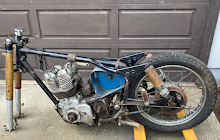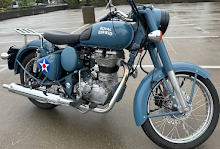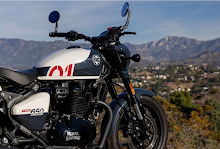 |
| You want a Royal Enfield because you recognize it. |
You should read Aayush Rathod's TopSpeed article about Royal Enfield and the popularity of motorcycles that look old-fashioned but function as well as modern motorcycles.
It's entitled Retro Revival: How Retro-Styling Is Taking Over The Industry.
I'm not so sure about the headline. The article provides no hard statistics to show that Royal Enfields or any retro-styled brand is outpacing other looks. As a former newspaper copyeditor, I know that the author of the article and the writer of the headline are often two separate people.
But that doesn't mean the headline is necessarily wrong: we know that Royal Enfield is going Great Guns, and competitors are moving fast to muscle into the retro market worldwide. In the United States, Harley-Davidson and Indian are long on retro, and they are everywhere on our streets.
"Everyone and their grandmas are eyeing such motorcycles," the author writes, and his explanation for why this is so strikes me as right on.
Read the article, which is well reasoned, nuanced, and amusingly written. But allow me to repeat and briefly expand on some of the points he makes:
Really old motorcycles were unreliable, leaking, vibrating contraptions. But they established the definition of "motorcycle."
Naked, with parts that you could see and recognize. Rugged (even if unreliable).
Simple (if crude by modern standards). Broken, they could be fixed without calling in a specialist.
Tight-fisted customers who needed to ride to work (not just to play) liked what they knew and bought it. Rathod compares the motorcycles of the day to denim pants. Never fully in style. Never really out of it.
Time created tremendous brand familiarity. Harley, Indian, Triumph, BSA, Norton. Even, in India at least, Royal Enfield.
The old motorcycles weren't just the thing of the moment. They were, to use Rathod's word, "timeless."
And modern motorcycles (always on the cutting edge) are not timeless. Simple as that.
But so what? Who values timelessness?
Rathod supplies the answer: effectively, everybody human.
Here's the proof: roll your retro out of the garage and see the number of times people signal their admiration, ask how old it is, and whether you "restored it yourself."
No, I don't mean that you're looking to be admired and, frankly, it's hard to have to admit that you didn't restore it; you just paid for it at a dealership!
My point is that the onlooker is the one experiencing the pleasant thoughts, perhaps of days gone by. Even a child will recognize an old-fashioned looking motorcycle as the storybook symbol of freedom, fun, and adventure.
This is natural but it's also not left to chance. Brands are selling this to you. Rathod observes that modern marketing of any product is more about telling stories than comparing statistics.
The formula is to establish a human connection and then make the sale. Nostalgia is a powerful emotion. So is the hunger for the "joy of riding" conveyed by the iconic image of the simple motorcycle.
A retro-style motorcycles likely will not win any war of statistics with a high-tech superbike (except on price). But it is far ahead on emotion.
Crudely put, the subhead on Rathod's article tells us to "Expect more retro sports bikes, retro ADVs, and retro cruisers in the near future because they're all the hype."
Hype? Well, OK.
But sales actually depend on more than hype. Money changes hands when customers see real value in a product. Retro delivers.


























Aside from the styling, one thing a lot of modern bikes miss is comfort. The leaning forward, sport bike 'crouch' simply is not comfortable for a lot of riders over 30. Classic bikes stick to the proven 'sit up and beg' riding position. I think this is why I see far more used Continental GTs for sale than INTerceptors.
ReplyDelete